Hello and welcome to part three of our series on what the hell we mean when we say “top,” “bottom” or “switch!” Two weeks ago we talked about bottoms and submissives, last week we talked about tops and dominants, and this week we’re getting switchy, and also talking about people who don’t use these terms at all. Let’s get into it.
![]()
The Tops, Bottoms and Switches Sex Survey
Three weeks ago, I sent out a survey about these terms, and over 3.6k people showed up to share their tops and bottoms with me. These are the respondents’ demographics:
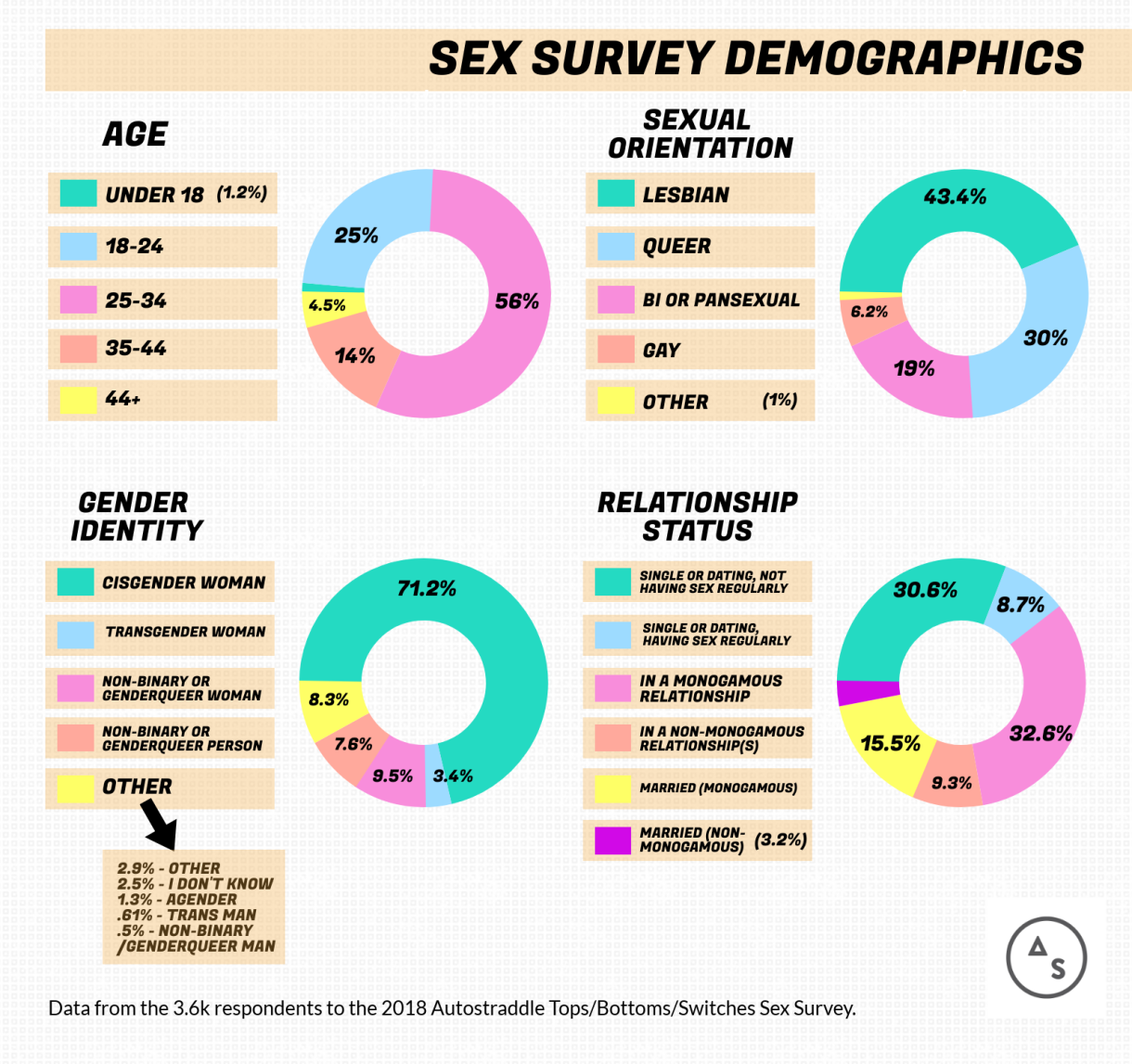
Demographics of Sex Survey Respondents // Age: Under 18 (1.2%), 18-24 (25%), 25-34 (56%), 35-44 (14%), 44+ (4.5%) // Sexual Orientation: Lesbian (43.4%), Queer (30%), Bi or Pansexual (19%), Gay (6.2%), Other (1%) // Gender Identity: Cis woman (71.2%), Trans woman (3.4%), Non-Binary or Genderqueer Woman (9.5%), Non-Binary or Genderqueer Person (7.6%), Other (8.2%) // Relationship Status: Single or Dating, Not Having Sex Regularly (30.6%), Single or Dating, Having Sex Regularly (8.7%), In a Monogamous Relationship (32.6%), In a Non-Monogamous Relationship (9.3%), Married & Monogamous (15.5%), Married & Non-Monogamous (3.2%)
I’ve been going through the data gradually over the course of the month — next week we’ll talk about sub-identities and the week after that we’ll talk about not-previously-discussed interesting trends in the data as a whole. Each week’s data builds on last week’s, we’ve all had a great nerdy sexy time with this and will continue to do so.
How Many Switches Are Out There?
Despite all the talk of tops and bottoms within the queer community, our survey revealed that people who identify specifically as tops or bottoms are in the minority overall. We switches, however, are ABUNDANT.
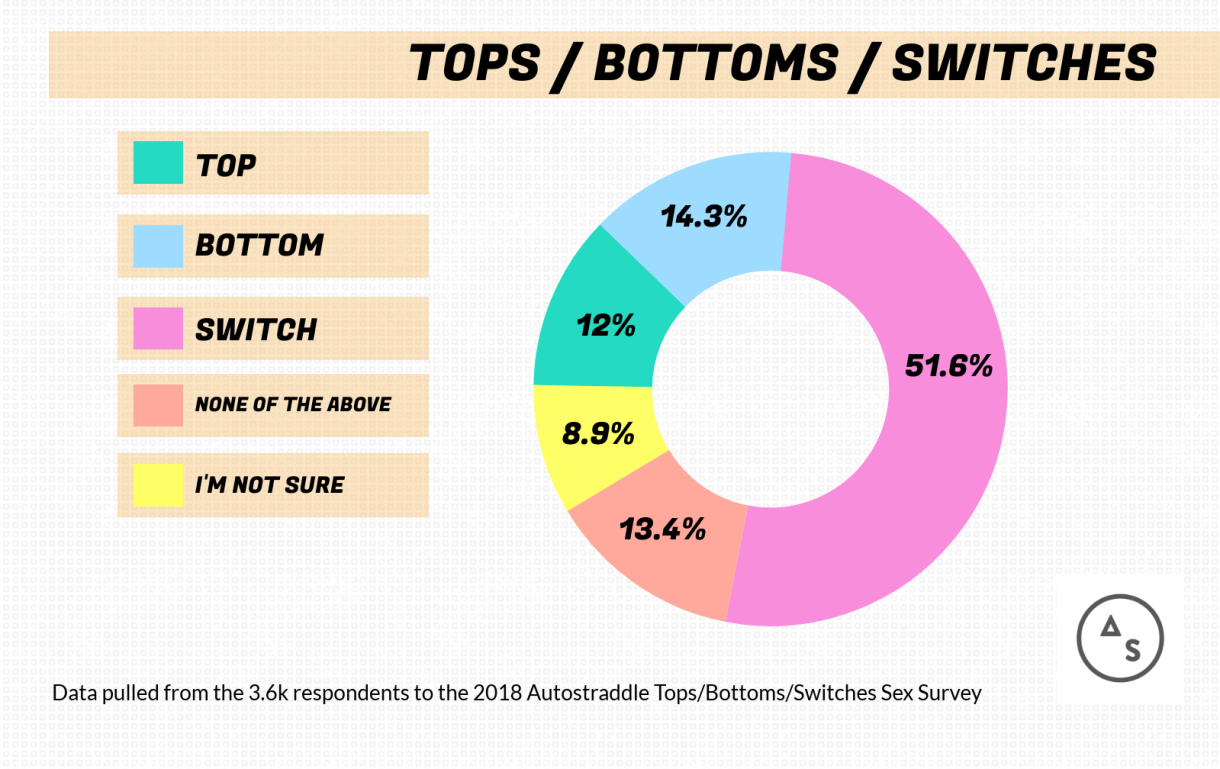
Tops: 12% // Bottoms: 14.3% // Switches: 51.6% // None of the Above: 13.4% // I’m Not Sure: 8.9%
What Is Switching?
Before queer women’s culture adopted top/bottom as terminology relevant to non-kinky sex, the terms were primarily used by gay men, or in kink or BDSM contexts by both straight and LGBTQ+ people. However, the term “versatile” or “vers” tends to be employed in those contexts as often as “switch.” (Most see “versatile” and “switch” as interchangeable, others don’t.)
There was obviously more consensus here than for tops and bottoms as defining “switch” rests heavily on pre-declared definitions of “top” and “bottom.” Switches were described as being interested in: topping and bottoming, giving and receiving, fucking and getting fucked, being the aggressor and the submissive, having control and not having it, giving and receiving pleasure, leading and following. Of course, there are plenty of sexual acts that aren’t easily defined by topping/bottoming, although top/bottom dynamics can absolutely be present in side-by-side grinding or even mutual masturbation — maybe this is less so when switches are involved, maybe not! Who can say!
![]()
What Do Switches Like to Do in Bed?
Despite a stated equal interest in giving and receiving most sexual acts, there were a few acts for which the percentage of switches who were down for giving exceeded the number who were up for receiving. The biggest disparities of that nature were for vaginal fingering (13%), genital oral sex (11%), nipple play (12.5%) and anal (8.7%).
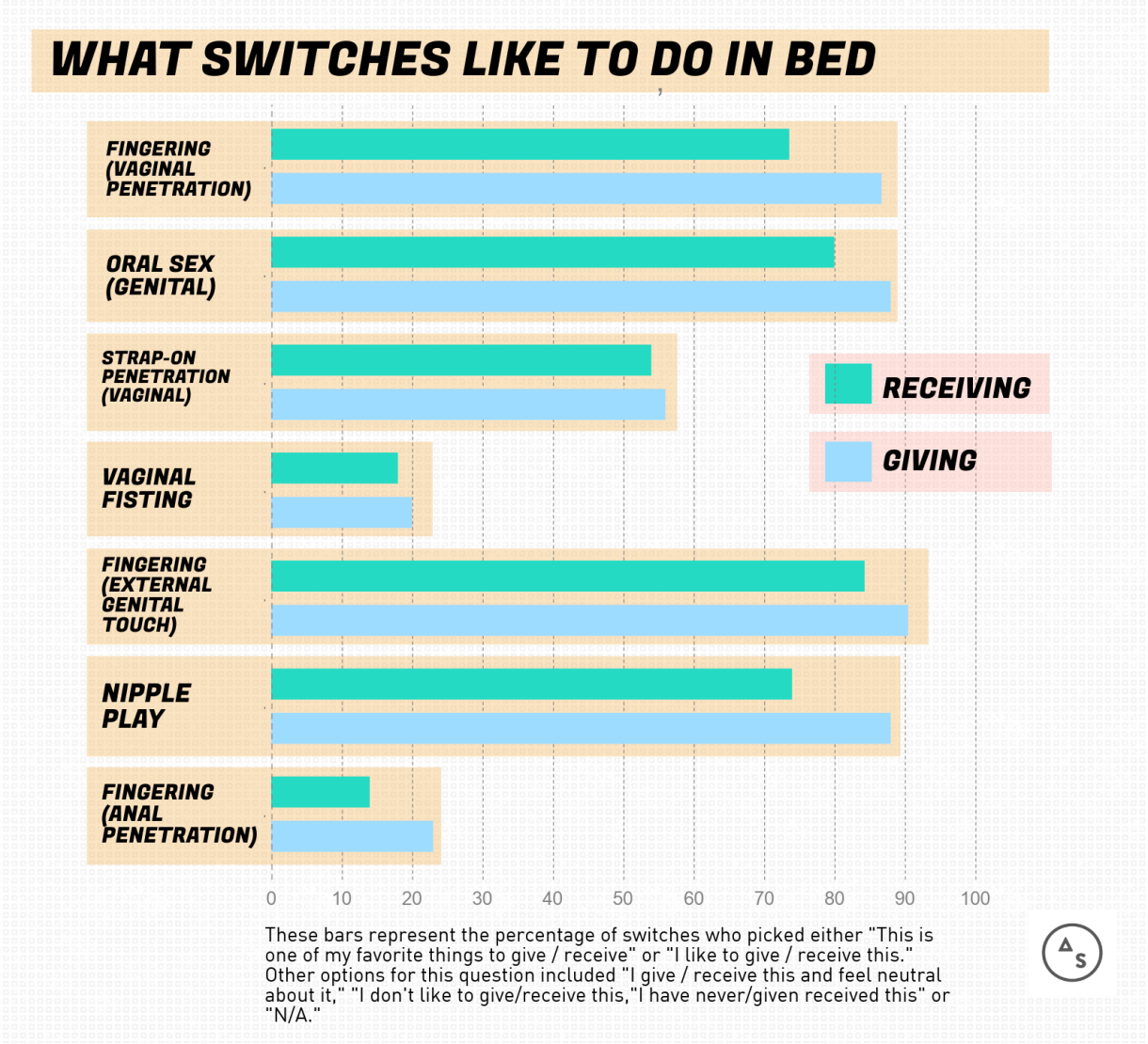
WHAT SWITCHES LIKE TO DO IN BED: Fingering (vaginal penetration) 90.5% like giving, 84% like receiving // Oral sex (genital): 88.3% like giving, 79.9% like receiving // Strap-on penetration (vaginal): 56.32% like giving, 54.05% like receiving // Vaginal Fisting: 19.9% like giving, 18% like receiving // Fingering (external genital touch): 90.53% like giving, 84.27% like receiving // Nipple Play: 86.4% like giving, 74% like receiving // Fingering (anal penetration): 22.78% like giving, 14.05% like receiving.
I noticed that in many areas, the percentage of switches interested in a certain sexual act or dating behavior was usually just slightly below the interest of tops (for top-associated) things, or of bottoms (for bottom-associated things). Here’s an infographic about that:
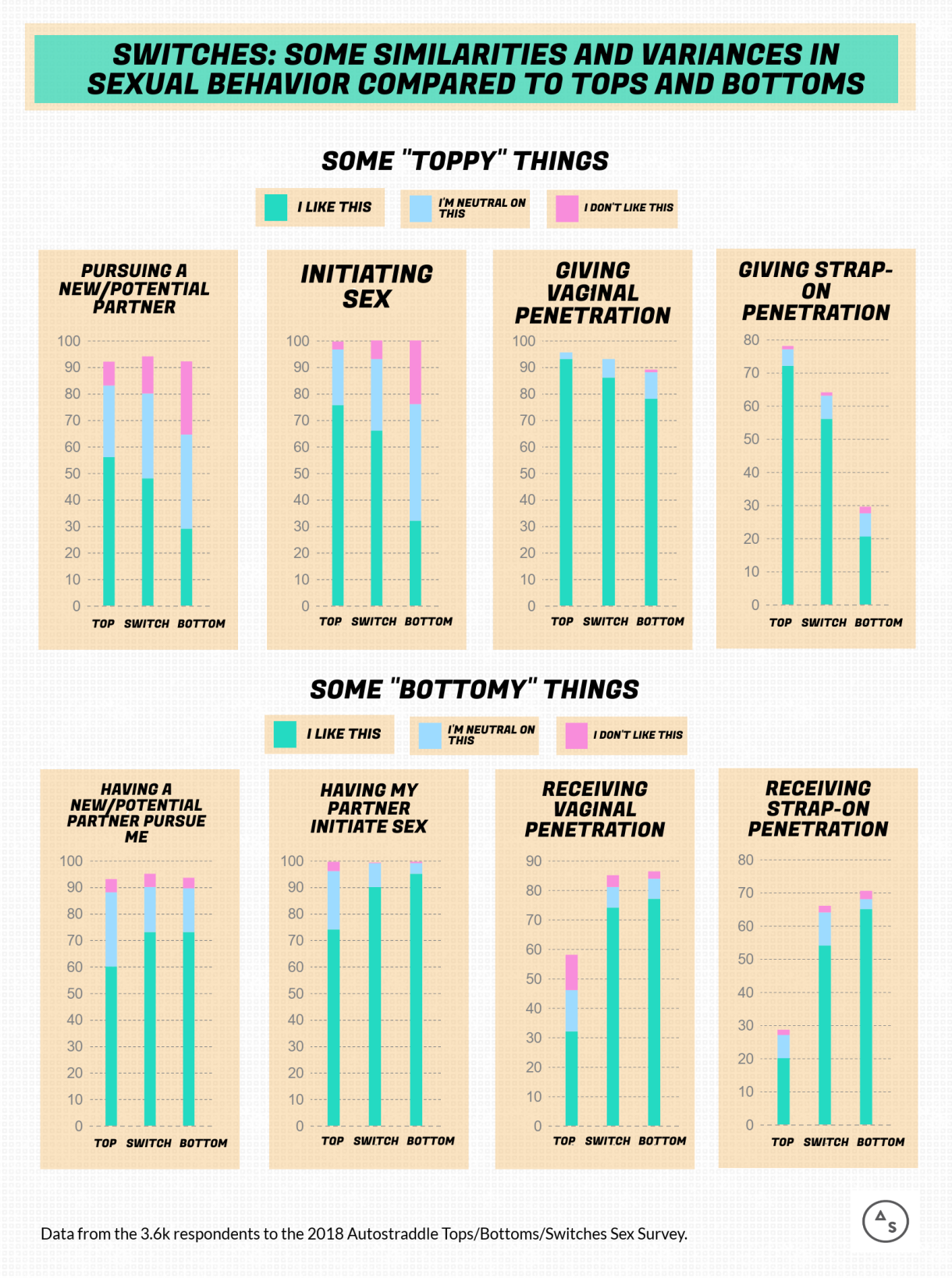
Switches: we sure are switchy!
![]()
So, Being a “Switch” Can Mean…
Doing a Little Bit of Both
“[A switch is someone] who spends time in both roles,” wrote one kinky lesbian femme, “but not just ‘she fucks me then I fuck her quickly afterwards’ but someone who enjoys equally spending time in each role.”
Preferring One, But Being Down For Both
Others indicated that an interest in both positions did not preclude a preference towards one. One trans lesbian who also identifies as a submissive described being a switch as: “Someone who can play either role but not necessarily in a 50/50 capacity; some people can lean more towards top and vice-versa.”
A lesbian femme added to her description that “a person could also PREFER being a top/bottom, but still enjoys both.”
Doing One Or The Other Depending On…
Their partner’s preference.
“I’ve fulfilled both roles (top/bottom) in my life,” said one queer woman. “I definitely prefer to bottom but will top if the person I am sleeping with prefers to bottom.”
“If I’m with someone who’s a great bottom, I like topping them,” said a soft butch lesbian. “But if I’m with someone who’s a great top, I like it when they top me.”
Sometimes, the switch identity is still in theoretical stages due to a perceived lack of experience with both, like the lesbian who wrote: “My ex-girlfriend very strongly identified as a bottom, so I ended up topping a lot more with her, which I enjoyed, but I’m still unclear if I liked that because I liked topping or just because I liked topping her, or just because I liked her, period. I feel like unless you have a lot of sexual partners, it’s hard to sort of nail these things down.”
Other aspects of their partner’s identity.
“I tend to want to be dominant with women younger than me and submissive with older women,” wrote a masculine/hard femme woman. “Overall I’m naturally more of a ‘top’ but I do like the idea of being a ‘bottom’ in the right situation or with the right person.”
Gender and gender presentation factored in as well (which has also been my own personal experience). “I am more submissive when with another androgynous woman,” wrote one genderqueer woman, “versus being dominant or wanting to top with femme women.”
How they feel that day.
“I like giving and receiving — sometimes I’m in a more dominant mood and sometimes more submissive,” said a lesbian femme.
“Personally, it’s sometimes wanting to just fuck someone up (in a way they love) and sometimes it’s wanting to be fucked up,” wrote a queer trans femme.
Fluidly Moving Between Top and Bottom in the Same Relationship or Sexual Encounter
“Sometimes I like to be a lil more in charge, sometimes I like to give my partner more of the reins; sometimes I like to give exclusively and sometimes I like to receive and give,” wrote one queer soft butch who also wanted me to know that their Venus is in Gemini. “I feel like ‘switch’ is the only term that gives me the space to move between different combinations of the above. Just topping or bottoming sounds like a lot — like i’m not even sure I would know how, or what that would entail, or if I would get bored or feel unsatisfied?”
“I love making jokes about top/bottom stuff,” said one lesbian. “But in reality I think queer girl sex is so much more expansive and fluid (pun?).”
All of the Above and More
One non-binary queer noted: “[Being a switch] can mean moving between roles during sex with a single partner. Or it can mean that with some partners you top and others you bottom, or on a given day you might do one or the other. Switch can be a light thing, where somebody doesn’t occupy either role fully, but I think of ‘true switches’ as people who have fully occupied both bottoming and topping roles. I think true switches are also very powerful, because we know what it feels like have complete control and to completely give up control.”
![]()
Kinky Switches
27% of switches identify as kinky (compared to 26% of tops and 41% of bottoms) and 55.5% don’t identify as kinky but enjoy kinky sex (compared to 53% of tops and 44.4% of bottoms). “A switch is someone who enjoys both the dominant and submissive role,” says Sophie St. Thomas in The Beginner’s Guide to BSDM Words. “Get thee a girl who can do both.”
What Do Kinky Switches Like?
As with other activities on this survey, switches tended to fall a little closer to tops on the toppy activities and a little closer to bottoms on the bottomy activities.
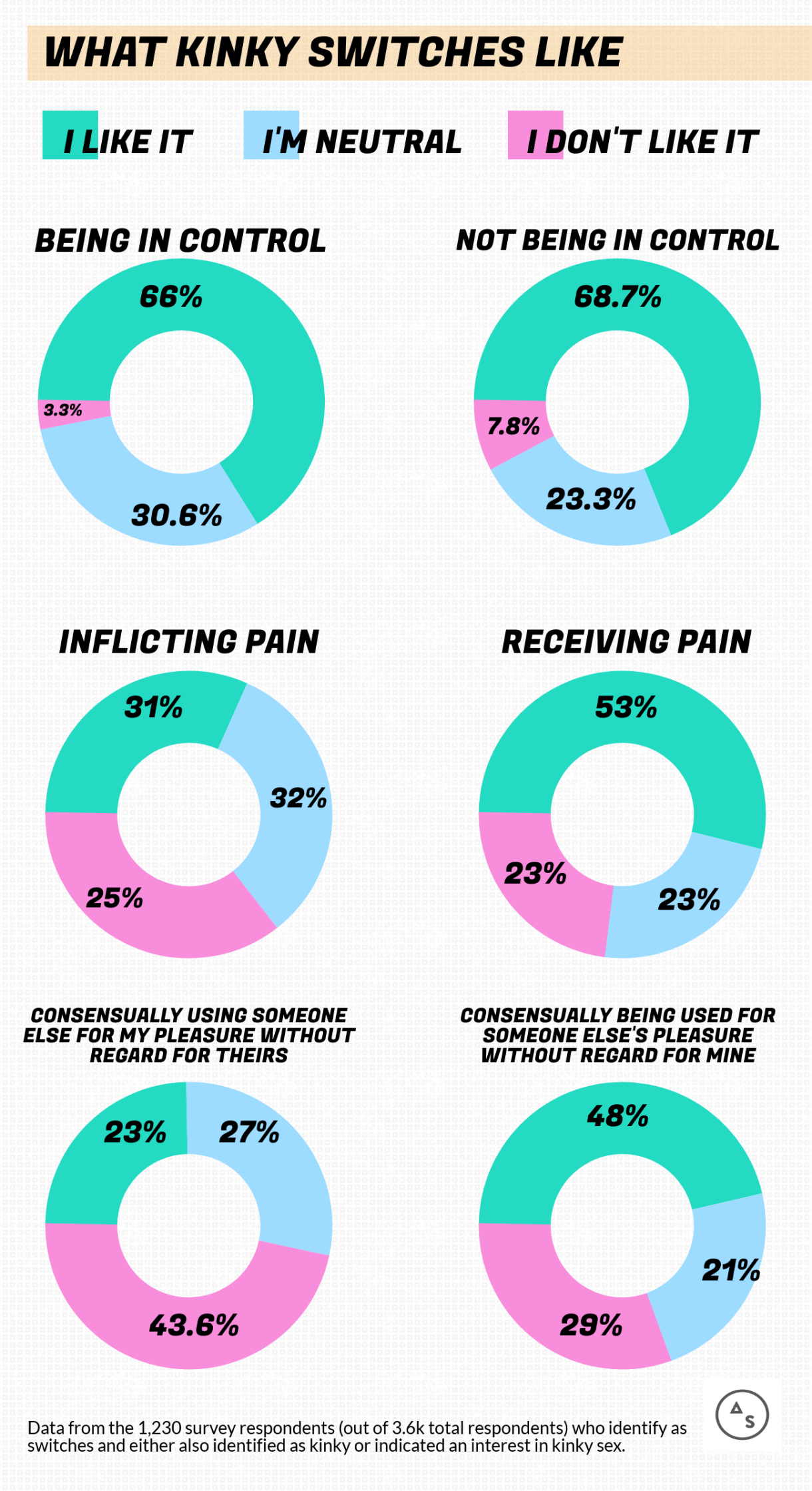
What’s interesting is that the not liking a thing is when switches tend to line up with tops, moreso than the liking of a thing. 25% of tops don’t like inflicting pain; neither do 25% of switches. 45% of tops and 43.6% of switches don’t like consensually using someone else for their pleasure. 1% of tops don’t like being in control — neither do 3.5% of switches. It doesn’t line up quite as well with bottoms, but it’s not too far off either.
In consultation with our former NSFW editor Carolyn, we decided to separate kinky switches from all switches, so only kink-identified survey-takers were subjected to an additional survey page with questions about dominants/submissives and sub-identities therein.
![]()
How Many Kinky Switches Are Out There?
Switching: also the most popular identity for kinksters!
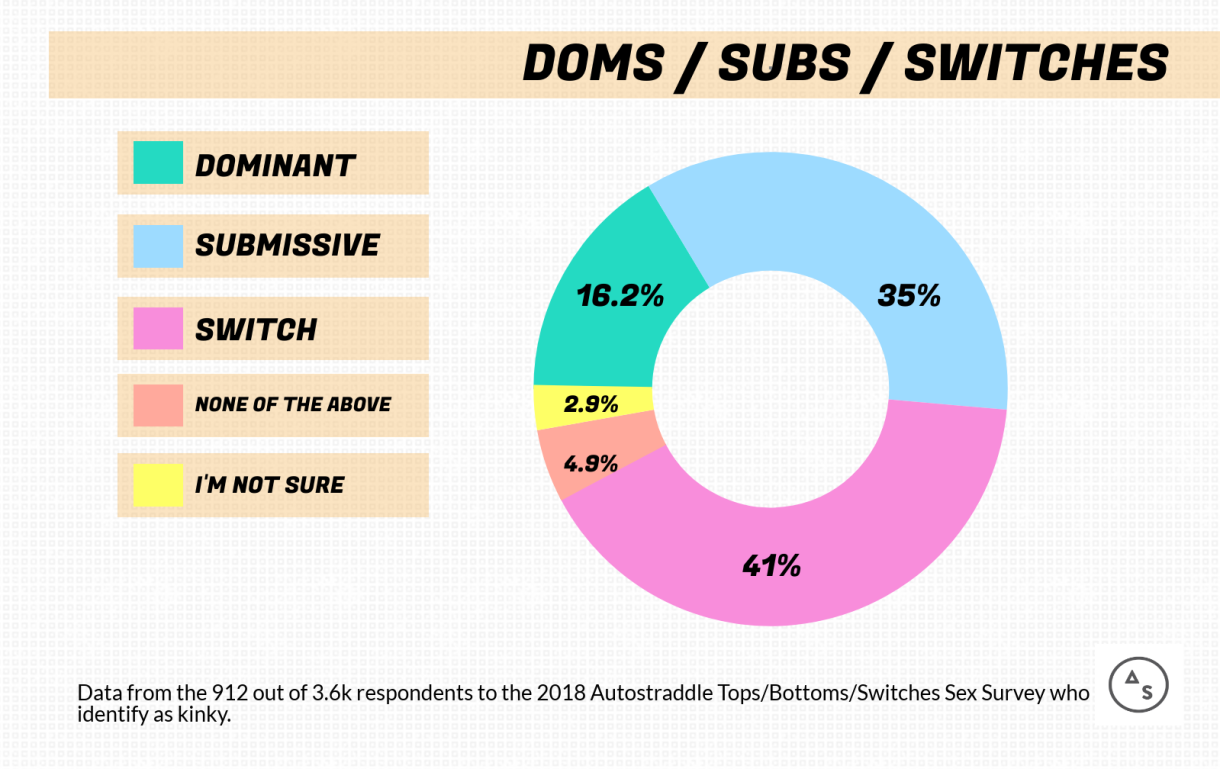
16.2% dominant, 35% submissive, 41% switch, 4.9% none of the above, 2.9% I’m Not Sure.
Of the 1,909 switches on our survey, 358 identify as kinky. 68.6% of those switches identify as switches within a kink context, 17.6% as submissives, 7.7% as doms, 4.3% as “none of the above” and 2.3% are not sure. So the “dom shortage”/”sub surplus” we talked about last week comes from a few areas: more bottoms than tops identify as kinky and the ones that do are overwhelmingly likely to be submissives, and more switches identify as submissives than dominants.
What Does It Mean to be A Kinky Switch?
Kinky switches reported a wide range of experiences for how switching played out in their sexual lives. “I really enjoy both domming and subbing when it comes to sex,” wrote one bisexual femme. “In the rest of my life, I absolutely want an equal relationship with everything and would be very uncomfortable with any kind of general power exchange, but I find power like a fine wine — it feels delicious, and there’s something really beautiful about someone surrendering to me and obeying my orders. But I also really enjoy giving up control. Bottoming is one of the only times in my life I ever really stop worrying about everything and only worry about pleasing my partner. With the right top, it quiets my anxieties and makes me feel so warm and cared about.”
“I’m currently in a D/s relationship where I am the sub-type person and am mostly subbing lately,” wrote a queer femme. “But I have experience and desires that revolve around dominance as well, hence my identification as a switch.”
Although our survey was specifically about sex with people who don’t identify as cis men, a few switches told us in the open response area that they top men but bottom for women. “Bottoming and subbing for women makes my gay little heart quiver with joy,” wrote one. “Topping/domming men is pretty rad too.”
Some switch within their present relationship, like the queer non-binary tomboy femme who told us, “My partner and I switch roles, sometimes in the same session, depending on how we’re feeling that day. She leans more subby than I do, so I end up domming more often.”
Other times the switching is act-specific. “In general, I really like to dominate my partners verbally, but am not that into inflicting pain (unless a partner really likes that),” wrote a gay femme. “Conversely, I am fairly neutral about being dominated, but do like to receive pain (having my ass slapped, cunt spanked, hair pulled etc). Receiving pain isn’t as much about D/s for me as it is about sharpening sensation so I can get out of my head and be present in the moment. It feels like turning off my brain, and grounding myself, via my body. ”
“When it comes to power I prefer domination,” wrote a poly genderfuck woman. “but when it comes to sensation I’m versatile. Different folks bring out really different strains of feeling for me.”
Or, kinky switching is an active role throughout the encounter. “I like switching ~itself~ as a sex act/move/style!” Wrote a queer soft butch switch. “Like, ‘oh you thought you were in charge? Surprise I’m in charge now’ – or conversely, ‘oh shit that thing you started doing really put me in a different place and now i would do literally anything you tell me and am receiving fully any idea you get or act you choose’ I love that push & pull.”
![]()
“None of the Above” vs. Switch
A question I got repeatedly when sharing the survey results with friends was “what’s the difference between None of the Above” and “Switch?” Isn’t it the same thing?”
Well… no.
As with most things that involve LGBTQ+ people, someone’s attachment to not labeling themselves is often just as meaningful and important to them as someone else’s attachment to labeling.
Many said their communities or relationships didn’t use top/bottom/switch terminology, others seemed a little bit mad at me, some were frustrated by the terms’ popularity and others were excited to learn more about these identities despite not feeling personally drawn to them. 7% of NOTAs used to identify as tops, 7% as bottoms, and 11% as switches; but 81% have never used any of these terms.
Most who provided additional commentary on their none-of-aboveness could be split into five camps of thought:
1. These terms aren’t appropriate terms for how lesbian & queer women have sex because [they’re for gay men, they’re kink-specific, they’re phallocentric, they require penetration, etc.]
“I’m not a ‘I don’t do labels’-believing person,” wrote one bisexual woman, “but these terms are all really and completely something I would never use even if I were a gay dude/super into BDSM. Yeah there are simple honest preferences, but there’s also the weird homophobic/misogynistic background of dividing ‘roles’ since at least the ancient Greeks.”
Another queer woman wrote, “Honestly, I’m not sure why the queer women’s community has adopted these terms, and I’m partly taking this quiz out of protest against the appropriation of gay male vernacular when queer women already had words for this.”
“I feel like it’s an attempt to make queer sex imitate or identify more with straight cisgender sex,” wrote another queer woman.
2. The kind of sex I have is too fluid for bottom/top/switch terminology.
“No relationship I’ve ever had has required one of us be designated a penetrator or one who is penetrated,” wrote the same queer woman I just quoted. “And that’s what I think is wonderful and beautiful about queer/lesbian sex, that there are no rules or requirements of how things are ‘supposed’ to be.”
“I prefer less control and [my partner] prefers more, but neither of us identifies as one or the other, and we both ‘give’ and ‘receive’ equally,” wrote one bisexual femme. “‘Switch’ feels like an identity where you’re flexible on being a top or bottom, but doesn’t really capture the in-between.”
“Sex is collaborative, and while those terms don’t denote otherwise, I think that oftentimes the mindset is that sex is being done to someone rather an a collaborative, cooperative act,” wrote a non-binary queer person. “That’s why I don’t like these terms.”
“In my experience, folks tend to describe and explain what they are into sexually rather than use a label to describe those sexual preferences,” said another queer woman.
3. I use these terms in kink, but not outside of it.
“If I’m having kinky sex then certainly sometimes these roles/terms apply,” wrote a bisexual genderqueer who identifies as a switch within a kink context, “but in the context of non-scene sex, I often don’t fall into only one role.”
“I strongly dislike the confines of sexual roles outside of a kink dynamic,” wrote a bisexual woman. “Kink & sex are two separate things that fulfill different needs and desires for me. Sex should be approached as fluid, active, engaged, and new and different every time.”
4. I’m still figuring it out.
Although “I’m not sure” was an option, some who felt unsure about their identification seemed to choose “none of the above” because uncertainty itself wasn’t their primary hesitation to identify.
“I like to say ‘I bottom in my current relationship,’ because I do — but that doesn’t *make* me ‘a bottom,'” wrote a survey-taker who didn’t finish their survey. “I want to explore my dominant side as well. I don’t consider myself a switch because I haven’t had the opportunity to see if I like topping yet.”
5. I identify with a term not included here.
This was most often “vers,” but sometimes were kink-specific terms. (At that point in the survey, survey-takers weren’t yet aware that they’d have a chance to talk about kink identities later in the survey.)
“I really don’t like these labels,” wrote a kinky NOTA about top/bottom/switch. “They’re just close enough to kink to be confusing without some of the clarity of most bdsm labels. Sometimes people think they mean your role in specific sex acts, sometimes they mean kink and it’s really unclear.”
![]()
What Do “None of the Aboves” Like to Do in Bed?
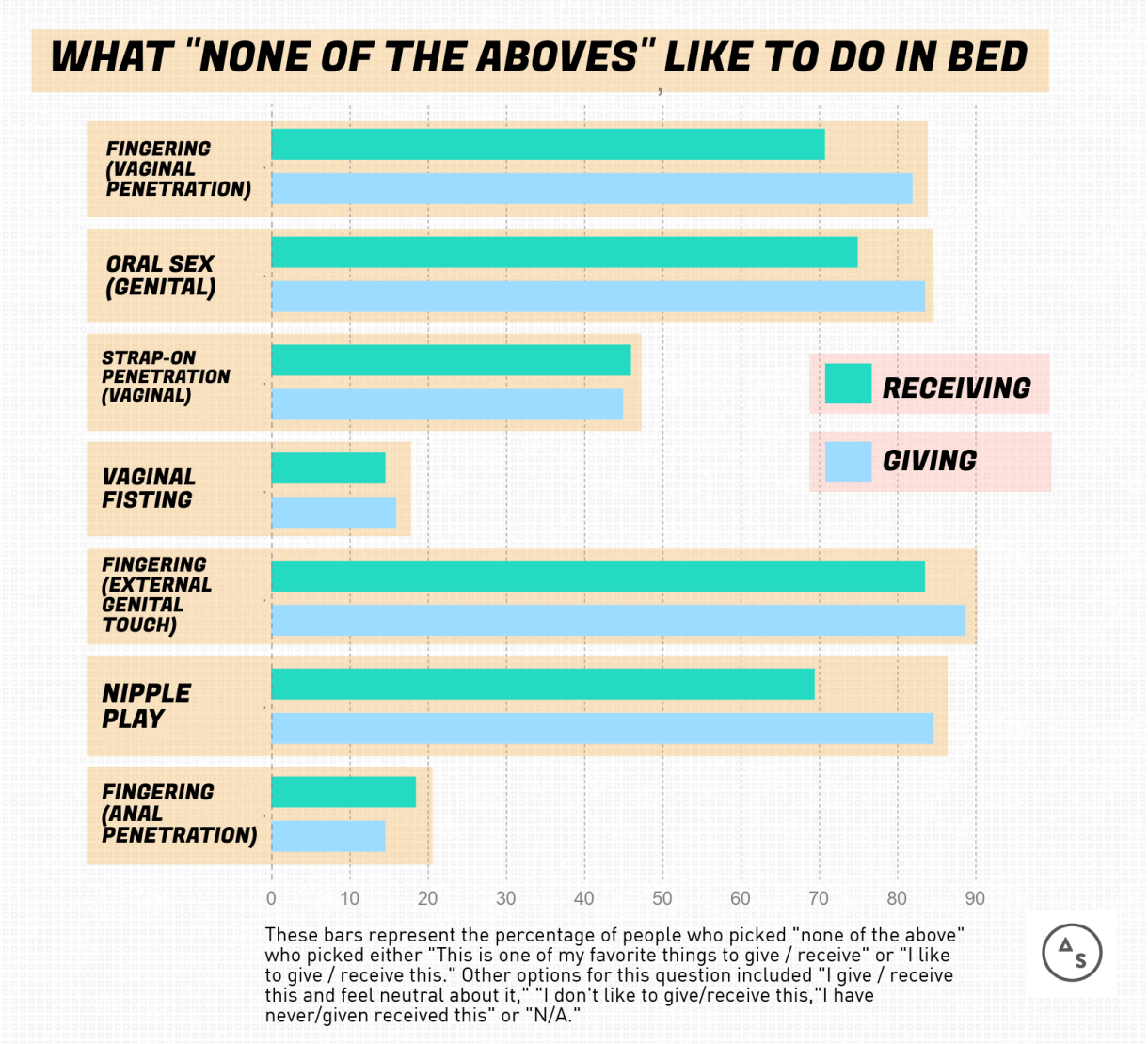
There weren’t any dramatic differences here between NOTAs and other groups. Smaller percentages of “none of the above” survey-takers were fans of various sexual activities than tops, bottoms or switches, but it’s also possible that NOTAs indicated less affiliation for those activities due to feeling distance from giving/receiving dynamics in general. Strap-on penetration had the biggest consistent disparity — around 44% of NOTAs were into giving or receiving it, compared to 72% of tops who like giving it, 65% of bottoms who like receiving it, and around 55% of switches who like to give or receive it.
![]()
None of the Aboves & Kink

NOTAs were way more likely to not identify as kinky or like kinky sex than other survey takers — 45.2% weren’t into kink at all, compared to 21% of tops, 14.7% of bottoms and 17.6% of switches.
That leaves us with 51 kinky NOTAs to overanalyze. For some, their resistance to top/bottom/switch labels were tied entirely to their relationship with kink. “Tops in the bedroom,” wrote one queer hard femme, “bottoms in the dungeon.” It seemed more than a few had picked “none of the above” for the earlier question because submissive, not “bottom,” was their chosen term, leading us to yet another area where we see the causes of the aforementioned sub surplus.
“I am a sucker for butchy top energy,” wrote another kinky queer woman who said she wasn’t into identifying with any specific term. “Like, I’ll submit so damn hard for a butch in boots, I’ll meld with the floor if that’s what they ask for… I pride myself on being a really good submissive, but sometimes when my wife and I are feeling kinky & playful, I’ll be a snarky brat on purpose and try to goad her into being stern and forceful with me. *swoon*. On the flipside, misandry is a huge turn on for me and when I picture myself in power it’s usually exerting control over a cis hetero male.”
One switchy kink-identified genderqueer woman also identified as a “vers,” which she defined as “someone who finds sexual satisfaction through giving AND receiving pleasure! Verses are NOT half tops and half bottoms they are their own majestic creatures.” Earlier in the survey, she declared, “Verses are absolutely 1000% the best sexual partners on the planet. Vers 4 Vers till the day that I die.”
![]()
Finally: Some Thoughts for You From Some “Nones of the Above”
“I am uncomfortable with those labels used in the context of sexual encounters that do not involve cis men,” wrote one queer woman. “For me, the magic of queer sex is to overcome the feminine/masculine binary, and I feel that using the top/bottom labels we are going back. But maybe the answers of this survey change my mind ;-)”
Another asked for this: “Can we talk more about categories and classification and historical impact and why categories might be weird and why we are attached to them??”
Personally, I take a “you do you” approach to all of this. If a label holds meaning for you, then by all means, embrace it. If it doesn’t, then it doesn’t! I like them. I love the memes and jokes we make around these terms (e.g., “In a Movie Full of Tops, Who Has the Most Top Energy in the Ocean’s 8 Trailer?“) and find it to be useful shorthand, but it’s clear that also not identifying with any of these terms is valid as fuck.
C U Next Tuesday to talk about sub identities! (E.g., “bratty bottom,” “pain switch,” “service tops”)
Lesbian Sex 101 is Autostraddle’s series on how to have lesbian sex for queer women and anyone who finds this information applicable to their bodies or sexual activities. Employment of the term “lesbian sex” in this post uses “lesbian” as an adjective to describe sex between two women or people who identify with that experience, regardless of the sexual orientation of the two people involved.
Sex ed almost never includes queer women or our experiences, so we’re exploring pleasure, safety, relationships and more to make that information more accessible.
A lot of the language in these posts is intended to make them easy to find on search engines.Some of the body parts we talk about will be yours or your partners’ and some won’t. Some of the pronouns will be yours or your partners’ and some won’t. Some of the sexualities will be yours or your partners’ and some won’t. Some of the language will be yours or your partners’ and some won’t. Take what you want and what applies to you or what you can make apply to you and your partners and your experiences, and leave the rest!



Someone on Fetlife wrote about being “ethalpenic” (I am fucking up the spelling, it’s a science pun) which basically meant that different people bring out different things in them. They were talking about kink but I could see some resonances in my own non-kink interests too. Specific people inspire specific dynamics, and those dynamics aren’t necessarily transferable. I don’t know if that necessarily counts as “switchy” except for I guess in a universal overarching sense; there’s more of an emphasis on individual connection rather than general trends.
I love this comment! Yes, so very yes…I think the way in which we can all bring out different elements of each other is one of the most fascinating aspects of human connection.
This is very interesting
I like that term a lot & has me thinking a bit. Thank you!
YES. This resonates with me so much more than top/bottom/switch labels
Some Googling leads me to believe the term I’m searching for is enthalpy, though I’m not entirely sure how that quite translates to the kink concept they’re talking about.
Wow I despise the idea that top/bottom is inherently heteronormative. Especially without any knowledge of the dynamics, negotiations, and types of care between two people. In fact, I think it’s this mindset in queer communities that keeps so many of us ashamed of our desires. Let people want what they want and use the labels that make them feel good!
UGH sorry. I’m FIRED UP. But I didn’t have boring, vanilla-ass(less) sex for years to come out the other side and be told that my desires are het! They are queer as hell! Side note: any tops can @ me.
Anyway this series is rad, thank you so much for running it AS, I’m learning a lot about my community and all the wonderful variance in it!! TOP/BOTTOM IS FOR ALL QUEERS. GOOD DAY.
Yeah, this idea seems a little stuck in the 70s to me, much like “all penetration is heteronormative” and ideas about queer gender presentations just being “copies” of cishetero patriarchal gender roles. It’s just such a sad and boring way to look at something that seems soooooo queer to me. The only way that I agree is if people go around assuming all femmes are bottoms or just otherwise making assumptions about people’s preferences based on how they look — now *that* seems shitty and, sure, kinda heteronormative to me.
I get why people could be uncomfortable with using the terms for themselves, but honestly I kinda love and think it’s super extra queer that so many of the survey responses and comments on these posts seem to define these terms completely differently and are often like “who knows what these words mean! here is what I say, but I sometimes think/say the opposite?? and I want to learn more about what other people say!”
here to echo what people have noted in the comments and say that FOR ME, the top/bottom dynamic does not subscribe in any fixed way to a “feminine/masculine binary!” I’ve topped and bottomed for people of various genders since I came out (oh hi! personal information!) and that whole big bag of fun and tricks sometimes included gender play that didn’t actually have much to do with our actual genders as we understood them at the time, and was sometimes more genderless. SO!
that being said, as with anything sexual, do what you like and not what you don’t! <3
High five to the Venus in Gem!! Yo!! XD
As for the person wanting to discuss why people are so attached to labels, the people who like to research this stuff say it’s a psychological thing. I’m guessing it has to do with the oft mentioned fear of the unknown and wanting to categorize everything because those things that are categorized are purportedly easier to remember and understand. It could also be a “for the sake of the community” type thing; we see a rainbow, we think we might have a chance or we’ve at least found a place or a person who won’t attack us because of that part of our identity.
Anyway, I find people’s distaste of pursuing AND being pursued disconcerting…..
this was fascinating, thank you for your research!
I think the definition of top/bottom dynamics as being centered around penetration is just baggage from gay men’s use of it, which still often positions cis men’s genitals as instruments of domination and has loads of boring/sad patriarchal baggage.
The advantage of using such terminology to describe queer women’s sex may be that it can destabilize some of that baggage. Queer women, both cis and trans, seem a lot freer because we aren’t beholden to the same obsession with top/bottom dynamics revolving around penetration/phallic nonsense.
amen!
I think I like girls
What about intersex people (me for short) ? I am just curious “(^ . ^)”